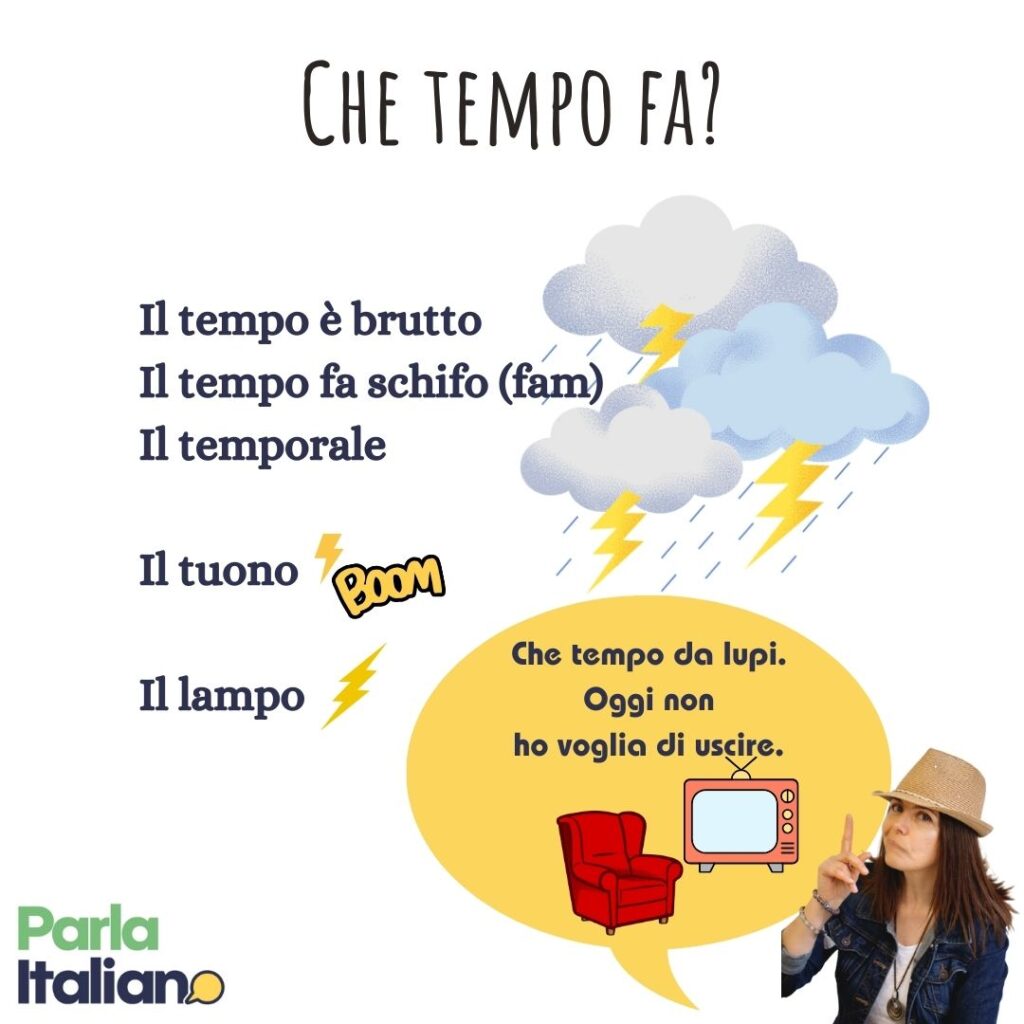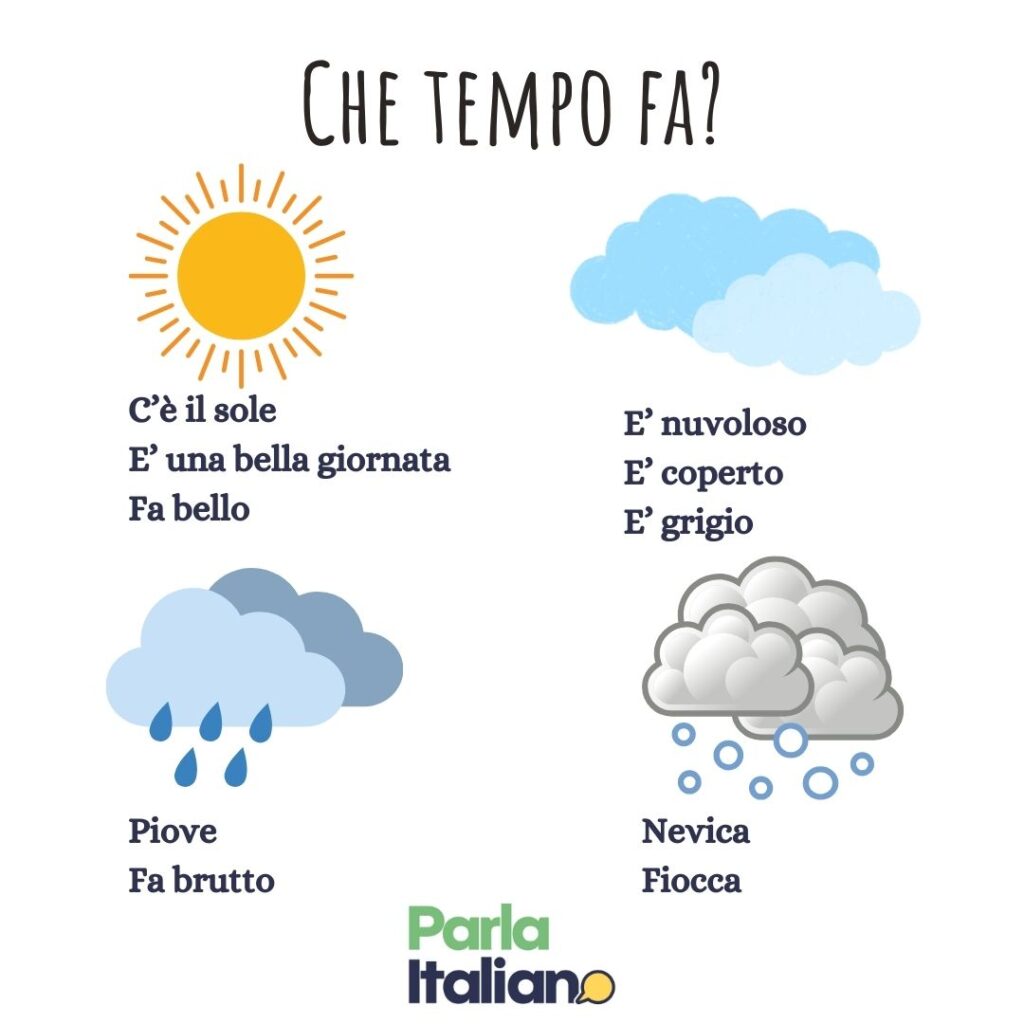Let’s discuss everyone’s favorite icebreaker – the weather! In this blog you’ll learn how to talk about the weather in Italian. Discover how to effortlessly express and understand weather-related terms in Italian. Plus, we’ve got conversation starters to help you mingle like a local.
Learning a new language can be a breeze when you have the right tools, and one of the most engaging ways to learn is by exploring topics that are relevant to your everyday life. If you’re a student of Italian, there’s no better topic than the weather to get you started. After all, it’s a conversation starter, a topic of small talk, and a way to connect with locals when you travel to Italy.

Sunny Days – Belle giornate
Italian Vocabulary:
– Il sole (sun)
– Il caldo (hot)
– L’afa (heath, muggy)
– La temperatura (Temperature)
– L’estate (summer)
– Luminoso (sunny)
– Brillare (to shine)
Italian Phrases
Take a look at these Italian phrases; they range from beginner to more advanced levels. Some of them are very commonly used, but they might sound strange because there is no exact translation. For example: Fa un caldo boia.
1. It’s a sunny day:
– E’ una bella giornata.
– E’ una bellissima giornata.
– È una giornata soleggiata.
2. It’s so hot
– Fa caldissimo
– Fa molto caldo
– Fa un caldo da morire
3. It’s damn hot
– Fa un caldo boia
4. It’s hot enough to fry an egg
– C’è un sole che spacca le pietre
5. Summer is my favorite season.
– L’estate è la mia stagione preferita.
How to start a conversation…
Now, let’s put all this vocabulary into practice. Here are a few ways to strike up a conversation in Italian:
- Fa caldo oggi, eh? (It’s hot today, isn’t it)
- Che bella giornata! Si sta proprio bene, non credi? (What a beautiful day. Such a lovely weather, isn’t it?)
- Mamma mia che afa, eh? (My goodness what a muggy day, isn’t it)

Rainy Days – Giornate Piovose
Italian Vocabulary:
– La pioggia (rain)
– La nuvola (cloud)
– L’ombrello (umbrella)
– Il temporale (thunderstorm)
– Il lampo (lightning)
– Il tuono (thunder)
– Bagnato (wet)

Italian Phrases
1. Sta piovendo. – It’s raining.
2. Ho bisogno di un ombrello. – I need an umbrella.
3. I miei vestiti sono bagnati. – My clothes are wet.
4. Stasera ci sarà un temporale. – There will be a thunderstorm tonight.
5. Three ways of saying: It’s pouring
– Piove a catinelle.
– Diluvia.
– Piove a dirotto.
How to start a conversation…
- Ma quanto piove oggi, vero? (So much rain today, isn’t it?)
- Guarda come diluvia oggi, smetterà? (Look at all this rain, will it stop?)
- Quanta pioggia, eh? (So much rain, isn’t it?)

Windy Days (Giornate Ventose)
Italian Vocabulary:
– Il vento (wind)
– La tempesta (storm)
– La raffica di vento (gust)
– L’aquilone (kite)
– ventoso (blustery)
Italian Phrases
1. C’è molto vento oggi. – It’s very windy today.
2. Le raffiche di vento sono forti. – The gusts of wind are strong.
3. Il vento spazza le foglie dagli alberi. The wind sweeps the leaves
How to start a conversation…
- Che vento oggi, vero? (What wind today, right?)
- Questo vento da proprio fastidio, non credi? (This wind is really annoying, don’t you think?)

Snowy Days (Giornate Nevose)
Italian Vocabulary:
– La neve (Snow)
– Il fiocco di neve (Snowflake)
– La nevicata (snowfall)
– Il gelo (Frost)
– Il pupazzo di neve (Snowman)
– Sciare (to ski)
Italian Phrases
1. Sta nevicando! – It’s snowing!
2. Fa un freddo cane! – it’s freaking cold!
3. Si muore di freddo! – I’m freezing to death!
2. I fiocchi di neve sono così belli. – Snowflakes are so beautiful.
3. Mi piace sciare sulla neve fresca. – I enjoy skiing on fresh snow.
4. Abbiamo costruito un pupazzo di neve. – We built a snowman.
How to start a conversation…
- Cosa pensi di tutta questa neve? What do you think of all this snow?
- Bella la città innevata, vero? (The city looks beautiful covered in snow, doesn’t it?)
- Ti piace la neve? (Do you like snow?)
- Ti piace sciare? (Do you like skiing?)
Cloudy Days (Giornate Nuvolose)
Italian Vocabulary:
– La nuvola (Cloud)
– Il cielo coperto (Overcast)
– La pioviggine (Drizzle)
– Le previsioni (Forecast)
– Grigio (Grey)
Italian Phrases
1. “Oggi è coperto” – Today is cloudy.
2. “Oggi c’è una leggera pioviggine.” – There’s a light drizzle today.
3. “Mi sento un po’ cupo con questo tempo.” – I feel a bit gloomy in this weather.
How to start a conversation…
- E’ proprio grigio oggi, eh? (It’s really grey today, isn’t it?)
- Mamma mai che grigiore oggi! (My goodness, it’s so grey today!)
- Hanno previsto pioggia per domani, giusto? They forecasted rain for tomorrow, right?
Foggy Days (Giornate Nebbiose)
Italian Vocabulary:
– La nebbia (Fog)
– La bruma (Mist)
– La visibilità (Visibility)
– La foschia (Haze)
– I fari (Headlights)
– Ocuro, fosco, opaco (murky)
Italian Phrases
1. “La nebbia rende la visibilità bassa.” – The fog reduces visibility.
2. “Mi piace l’atmosfera misteriosa della nebbia.” – I like the mysterious atmosphere of fog.
3. “Guida con i fari accesi quando c’è la nebbia.” – Drive with your headlights on when it’s foggy.
4. “La bruma rende tutto opaco.” – The mist makes everything look hazy.
How to start a conversation…
- Guarda che nebbia! (Look at that fog!)
- Mamma mia che nebbia che c’è! (My goodness, there’s so much fog!)
- Questa nebbia è preoccupante, non credi? (This fog is concerning, don’t you think?)
Getting the Most Out of This Blog
Now, let’s discuss how to make the most of this blog. Did you know that in order to effectively learn new vocabulary, you need to put it into practice through conversation or writing?
Simply reading and understanding it is not sufficient. So, I have a few of suggestions for you.
- Firstly, choose two or three phrases or words from the list that you particularly like and incorporate them into your next Italian lesson or conversation. Practice makes perfect, and integrating new vocabulary into your daily interactions is key to language acquisition.
- Secondly, take advantage of social media to reinforce your language skills. We’ve prepared a post for you where you can share information about the weather in your area. It’s an excellent opportunity to engage with the language and interact with fellow Italian learners. You can find the post on our Instagram page (@italianwithparlaitaliano).
- And here’s the exciting part: Parla Italiano offers conversation classes where you can practice small talk and engage in more sophisticated conversations with experienced instructors. These classes provide the ideal environment to sharpen your language skills and build your confidence. Don’t miss this chance to take your Italian language journey to the next level. For more info have a look here.
Conclusion
In conclusion, learning a new language can become an enjoyable journey when you have the right tools at your disposal. Exploring topics that are relevant to your daily life, like discussing the weather, is not only practical but also a fantastic way to engage with a new language. For Italian learners, weather-related conversations offer a valuable starting point.
In this comprehensive guide, we’ve delved into Italian weather vocabulary, covering various weather conditions from sunny days to snowy evenings. You’ve not only learned how to express and understand these weather-related terms but also received some useful conversation starters.
Remember, simply comprehending the vocabulary is only the beginning. To truly master it, you need to put it into practice through speaking or writing.
So, let’s continue this linguistic adventure together, one phrase, one word, and one conversation at a time.
Divertiti!







